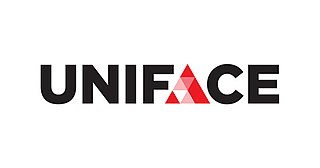
A database is an organized collection of data, generally stored and accessed electronically from a computer system. Where databases are more complex they are often developed using formal design and modeling techniques.

The OSGi Alliance, formerly known as the Open Services Gateway initiative, is an open standards organization founded in March 1999 that originally specified and continues to maintain the OSGi standard.

Eclipse is an integrated development environment (IDE) used in computer programming. It contains a base workspace and an extensible plug-in system for customizing the environment. Eclipse is written mostly in Java and its primary use is for developing Java applications, but it may also be used to develop applications in other programming languages via plug-ins, including Ada, ABAP, C, C++, C#, Clojure, COBOL, D, Erlang, Fortran, Groovy, Haskell, JavaScript, Julia, Lasso, Lua, NATURAL, Perl, PHP, Prolog, Python, R, Ruby, Rust, Scala, and Scheme. It can also be used to develop documents with LaTeX and packages for the software Mathematica. Development environments include the Eclipse Java development tools (JDT) for Java and Scala, Eclipse CDT for C/C++, and Eclipse PDT for PHP, among others.
Hibernate ORM is an object-relational mapping tool for the Java programming language. It provides a framework for mapping an object-oriented domain model to a relational database. Hibernate handles object-relational impedance mismatch problems by replacing direct, persistent database accesses with high-level object handling functions.
Maven is a build automation tool used primarily for Java projects. Maven can also be used to build and manage projects written in C#, Ruby, Scala, and other languages. The Maven project is hosted by the Apache Software Foundation, where it was formerly part of the Jakarta Project.
CherryPy is an object-oriented web application framework using the Python programming language. It is designed for rapid development of web applications by wrapping the HTTP protocol but stays at a low level and does not offer much more than what is defined in RFC 7231.

Uniface is a development and deployment platform for enterprise applications that can run in a large range of runtime environments, including mobile, mainframe, web, Service-oriented architecture (SOA), Windows, Java EE and .NET. Uniface is a model-driven, Rapid Application Development (RAD) environment used to create mission-critical applications.
The Spring Framework is an application framework and inversion of control container for the Java platform. The framework's core features can be used by any Java application, but there are extensions for building web applications on top of the Java EE platform. Although the framework does not impose any specific programming model, it has become popular in the Java community as an addition to the Enterprise JavaBeans (EJB) model. The Spring Framework is open source.

Eclipse Modeling Framework (EMF) is an Eclipse-based modeling framework and code generation facility for building tools and other applications based on a structured data model.

HeidiSQL is a free and open-source administration tool for MySQL and its forks, as well as Microsoft SQL Server, PostgreSQL and SQLite. Its codebase was originally taken from Ansgar Becker's own MySQL-Front 2.5 software. Due to having sold the MySQL-Front branding to an unrelated party, Becker chose "HeidiSQL" as a replacement. The name was suggested by a friend as a tribute to Heidi Klum, and was further reinforced by Becker's own nostalgia for Heidi, Girl of the Alps.
Tefkat is a Model Transformation Language and a model transformation engine. The language is based on F-logic and the theory of stratified logic programs. The engine is an Eclipse plug-in for the Eclipse Modeling Framework (EMF).
Jakarta Persistence is a Jakarta EE application programming interface specification that describes the management of relational data in enterprise Java applications.
Entity Framework (EF) is an open source object-relational mapping (ORM) framework for ADO.NET. It was a part of .NET Framework, but since Entity Framework version 6 it is separated from .NET framework.
Microsoft SQL Server is a relational database management system developed by Microsoft. As a database server, it is a software product with the primary function of storing and retrieving data as requested by other software applications—which may run either on the same computer or on another computer across a network. Microsoft markets at least a dozen different editions of Microsoft SQL Server, aimed at different audiences and for workloads ranging from small single-machine applications to large Internet-facing applications with many concurrent users.
The following tables compare general and technical information for a number of available database administrator tools. Please see individual product articles for further information. This article is neither all-inclusive nor necessarily up to date.
Model–view–adapter (MVA) or mediating-controller MVC is a software architectural pattern and multitier architecture. In complex computer applications that present large amounts of data to users, developers often wish to separate data (model) and user interface (view) concerns so that changes to the user interface will not affect data handling and that the data can be reorganized without changing the user interface. MVA and traditional MVC both attempt to solve this same problem, but with two different styles of solution. Traditional MVC arranges model, view, and controller in a triangle, with model, view, and controller as vertices, so that some information flows between the model and views outside of the controller's direct control. The model–view–adapter solves this rather differently from the model–view–controller by arranging model, adapter or mediating controller and view linearly without any connections whatsoever directly between model and view.
MyBatis is a Java persistence framework that couples objects with stored procedures or SQL statements using an XML descriptor or annotations.
The following

Oracle NoSQL Database (ONDB) is a NoSQL-type distributed key-value database from Oracle Corporation. It provides transactional semantics for data manipulation, horizontal scalability, and simple administration and monitoring.